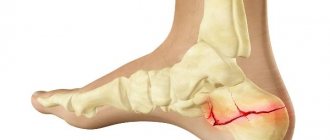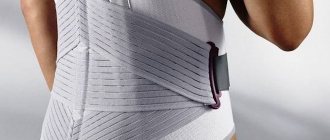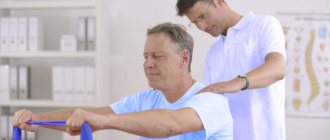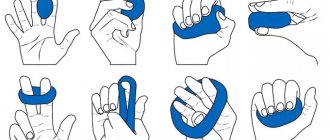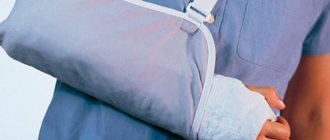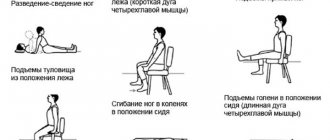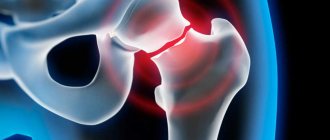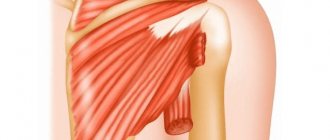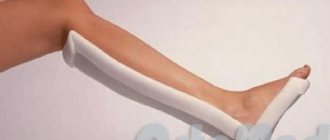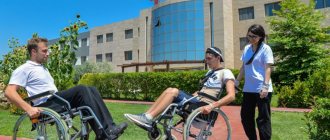A fracture of the ulna is quite rare; more often the radius or both bones are broken. Also, “Montaggi” damage is often observed, which is formed when falling or when trying to parry a blow with a bent arm (as in the movies).
After the bone heals and the cast is removed, it is necessary to develop the arm and return it to full functionality. Our selection of exercises will help you do this quickly and effectively.
My personal recommendation is to contact a specialist in muscle dysfunction or a qualified massage therapist and undergo 2-3 massage sessions to relieve muscle spasms.
Clothes should be loose, it is advisable to remove shoes. Perform all exercises (especially the first days) smoothly and gradually. Remember the important principle: “Endure mild pain, do not allow severe pain.”
Perform these exercises daily for at least 2 weeks.
Stretching exercises
Extension with table
Place your hands on the table, palms down.
Fingers are relaxed, elbows are straight. Gently move your body weight forward until you feel tension in your wrist. Hold for 15 seconds. Repeat 3 times. Do stretching exercises until the pain subsides and your arm gets used to the stress. Then begin strengthening exercises.
Strengthening exercises
Rehabilitation
The issue of rehabilitation must be approached especially responsibly, since this area is quite capricious. Doctors advise starting to develop the elbow joint after a fracture with small exercises for the fingers and shoulder joints immediately after applying a plaster splint, and a week after the fracture, isotonic contractions of the muscle tissue can be performed. They involve tensing a muscle without direct movement. This exercise is great for maintaining muscle tone.
In the second week after the splint has been applied, physical therapy can begin. It also helps maintain the tone of muscle tissue, helps improve blood supply processes, and accelerate the healing of affected areas. In some cases, the patient requires additional devices that help restore limb mobility.
Development of the elbow joint after a fracture: exercises
Development of the elbow joint itself is the second stage of rehabilitation. It is possible only after removal of the plaster splint and with the approval of a doctor.
The second stage of rehabilitation is usually very difficult, since in addition to following instructions, it also requires perseverance and self-control. If you do not devote enough time to developing the joint, you may never regain full mobility.
You cannot immediately bend your elbow after removing the splint.
First, the patient needs to perform simple exercises for the elbow joint after a fracture, which are performed with an outstretched arm. For example, he is asked to sit at a table, stretch his injured arm towards it and try to lift his elbow from the table only through movements in the shoulder.
Next, with the approval of the doctor, passive gymnastics begins. This cycle includes the following exercises:
- Place the injured hand on a flat, hard surface. With your healthy hand, perform flexion and extension movements in it.
- You can do fine motor exercises in the injured hand using a soft ball or stick.
- The arm is flexed and extended at the same time as it is raised behind the head.
How to forget about joint pain forever?
httpv://www.youtube.com/watch?v=embed/iuGTijeKnKo
Have you ever experienced unbearable joint pain or constant back pain? Judging by the fact that you are reading this article, you are already familiar with them personally. And, of course, you know firsthand what it is:
- constant aching and sharp pain;
- inability to move comfortably and easily;
- constant tension in the back muscles;
- unpleasant crunching and clicking in the joints;
- sharp shooting in the spine or causeless pain in the joints;
- inability to sit in one position for a long time.
{amp}gt;” target=”_blank” rel=”nofollow”{amp}gt; {amp}gt;” target=”_blank” rel=”nofollow”{amp}gt; {amp}gt;” target=”_blank” rel=”nofollow”{amp}gt;
Exercises and massage
Exercises to develop the elbow joint after a fracture should become more complex gradually as it develops. The patient needs to understand that it is impossible to remove the splint and immediately begin to act with the injured arm as if it were completely healthy.
Massage can also be used to restore mobility. Experts' opinions on this topic differ, but in many cases these manipulations are prescribed, although not immediately after the fracture. It is important that the massage is approved by a doctor.
You can perform a massage before the splint is removed, but in this case it will not be directed at the elbow joint, but at the shoulder girdle area. The procedure has a general strengthening effect on the body and, when performed correctly, is very useful.
One common mistake patients make during rehabilitation is placing excessive stress on the joint and passively using the limb. Please note that during this time you should not carry any heavy objects with your sore hand or do exercises that require support on your hands, such as push-ups and pull-ups.
It is also not recommended to perform exercises that provoke severe discomfort. There will be some discomfort, but it should not be too pronounced. Your task is to restore mobility to your hand, and not to complete the entire complex at any cost.
A fracture of the elbow joint is a fairly complex injury, and it always requires an extremely responsible approach to rehabilitation measures. If a person does not put in enough effort, he may be left with an impaired limb for the rest of his life. To prevent this, you need to take care of your own health and follow the instructions of a specialist.
Useful information: a set of exercises after a shoulder fracture
Proper and balanced nutrition also helps to speed up the process of recovery and return to normal life. Vitamins C and E have a beneficial effect on ligaments and joints.
Collagen is also important. This component is the main material for connective tissues in the human body and is responsible for their elasticity and firmness.
Collagen is found in large quantities in the following products:
- sea fish, any seafood;
- poultry meat;
- some fruits: peaches and persimmons;
- cereals: oatmeal, buckwheat.
Vitamin C helps strengthen the immune system, which is very important for fractures. Other vitamins for bones and joints are also important. They can be obtained from food and from additionally consumed vitamin and mineral complexes. The body directs all its resources to restore bone tissue, as a result of which it weakens and becomes more susceptible to various viruses and infections.
Sources of vitamin C from foods include cabbage, tomatoes, sweet peppers, rose hips, citrus fruits, and berries.
The human body is truly unique. Its tissues can be restored naturally. But you can help speed up this process significantly by performing all the necessary measures, including exercises to restore the elbow joint after a fracture. We invite you to watch a video demonstrating their implementation.
Features of contractures of various joints
The pathological position of the foot is caused by contracture of the ankle joint, when a person, when walking, can only rely on the front of the foot and the toes. This disease is also called “horse foot”. It occurs in children who have had polio or suffer from cerebral palsy. Adults acquire “cauda foot” after a long stay of the leg in an incorrectly applied cast. Contracture can also appear due to a fracture that is left without proper treatment. Often foot contracture occurs after injury.
The causes of contracture of the hip joint are injuries that damage the articular surfaces, as well as acute and chronic inflammatory processes. Formed as a result of a fracture, the disease can develop gradually, unnoticed by a person, or it can manifest itself immediately, for example, when nerves are damaged. Then, when trying to abduct the limb, the patient feels sharp pain and limited range of motion.
In order to prevent hip contracture, special attention should be paid to the hip joints of newborns. If there is a dislocation or dysplasia of the hip, it is necessary to begin treating the baby immediately after birth in order to promptly compensate for tissue underdevelopment and prevent the formation of contracture, coxarthrosis and other pathologies. Contracture of the shoulder joint is also common in people of all ages.
Its cause is often muscle atrophy due to long-term wearing of a plaster cast applied to the site of a fracture or dislocation.
Contracture of the shoulder joint also occurs in people of different ages. Its cause is often muscle atrophy due to long-term wearing of a plaster cast applied to the site of a fracture or dislocation.
The anatomical structure of the shoulder girdle of children and adults makes periarticular or intra-articular fractures possible, which are treated precisely by the method of prolonged immobilization. To avoid the appearance of post-traumatic shoulder contracture, when attaching a plaster cast to the fracture area, the patient’s shoulder should be abducted by sixty degrees and fixed in a functionally comfortable position.
The people were taken aback! Joints will recover in 3 days! Attach...
Few people know, but this is exactly what heals joints in 7 days!
//www.youtube.com/embed/dZRFQavhjwQ
httpv://www.youtube.com/watch?v=embed/iuGTijeKnKo
Physiotherapy
Physiotherapy procedures are prescribed to reduce swelling, reduce pain, relax muscles and increase their tone, as well as to improve blood supply and innervation to the affected area. In addition, they stimulate the growth of bone tissue. On the second or third day after injury, electrophoresis, magnetic and UHF therapy are used.
The callus forms in three to four weeks. To accelerate its formation, ultraviolet irradiation, electrophoresis with calcium and interference currents are used. When the bone becomes dense enough to withstand loads, laser, electrical stimulation and ultrasound are prescribed. On average, bone hardens over a period of 25 to 40 days.
If the bones take too long to heal or signs of pseudarthrosis appear, shock wave therapy (SWT) is prescribed. It can be supplemented with applications with ozokerite, therapeutic mud and paraffin, as well as pine baths.
Physiotherapy is treatment using physical factors: light, electric current, radiation and ultrasound, as well as therapeutic mud, mountain wax (ozokerite)
The type, quantity and sequence of procedures is determined by the doctor.
IMPORTANT: a physiotherapy course consists of 5–15 procedures.
When prescribing physical therapy, possible contraindications are taken into account:
- colds and exacerbation of chronic diseases accompanied by fever;
- active pulmonary tuberculosis;
- acute heart failure;
- presence of a pacemaker;
- osteomyelitis (bone inflammation);
- sepsis (blood poisoning);
- malignant tumors;
- pregnancy and lactation;
- childhood.
Recovery after a broken hand
In order to optimize blood circulation in the tissues and eliminate congestion, you should start working out your hand with rubbing. You can do them yourself; you need to lightly stroke and knead your hand. This manipulation will increase muscle tone, as well as improve oxygen delivery and dilate blood vessels. Specialists at the Yusupov Hospital recommend performing massages using various oils. A good option is to use cedar oil. This substance has a positive effect on the recovery processes of an injured hand. The massage should be light and performed immediately after removing the plaster. Over time, the intensity of the massage should be increased. You can involve a specialist in carrying out such a procedure. The Yusupov Hospital employs professional massage therapists who will help during the recovery phase after a broken hand.
After the bones grow together, you cannot immediately begin the usual loads. The sore hand needs a full recovery. During the period of wearing a cast, the limb is constantly immobilized. In this regard, the muscles weaken significantly in it and, accordingly, blood flows in a minimal amount. As a result, processes of tissue atrophy begin, that is, loss of vitality. You should begin rehabilitation after a broken hand on the same day that the cast is removed. At the Yusupov Hospital, the doctor will select the most optimal course for recovery after a fracture. Rehabilitation after a sanatorium-type arm fracture is carried out by specialists from a rehabilitation clinic. It consists of: massages, exercise therapy, organization of a balanced and proper diet. You can make an appointment with a specialist 24/7 by calling the Yusupov Hospital.
